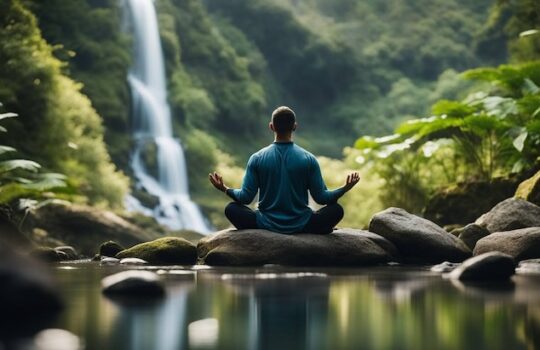Barefoot Grounding: Healing & Health Benefits & Effects of Earthing (Expert Tips & Advice)

Walking barefoot on natural surfaces like grass, sand, or soil connects you to the Earth’s energy, a practice known as barefoot grounding. Proponents believe this connection has many health benefits. Barefoot grounding may help reduce stress, improve sleep, and decrease inflammation.
Scientists are studying how direct contact with the Earth’s electrons influences your body. While research is still ongoing, people report feeling a unique sense of calm after grounding. Grounding might help balance your body’s natural energies and promote better overall health.
Using simple techniques like walking barefoot in your yard or on a beach can be an easy way to start grounding. Finding natural surfaces in your daily environment makes integrating this practice into your lifestyle straightforward. With minimal effort, you can likely experience the potential benefits of barefoot grounding.
Key Takeaways
- Barefoot grounding connects you to the Earth’s energy.
- Grounding may reduce stress and improve sleep.
- Simple techniques make it easy to incorporate into daily life.
The Science of Grounding

There is science behind grounding that focuses on the flow of electrons and its potential health benefits. This section explores how earthing, the role of electrons, and scientific studies contribute to understanding grounding.
Understanding Earthing
Earthing involves direct contact with the ground. Walking barefoot on soil, grass, or sand helps connect you with the Earth’s natural energy. This practice aims to balance your body’s electric potential with the Earth’s electric charge.
It’s believed that this connection improves health by reducing stress levels, boosting mood, and lowering inflammation. Many people find this practice simple and beneficial.
Electrons and Antioxidants
Grounding allows electrons from the Earth to enter your body, which can be beneficial. These electrons act as antioxidants, neutralizing free radicals and unstable molecules that can damage cells.
Grounding may help decrease inflammation and support overall health by reducing free radicals. This electron flow might explain why people feel better after spending time barefoot on natural surfaces.
Research and Studies
Several studies have looked into the effects of grounding. Research shows that grounding can improve sleep, reduce pain, and lower stress. Some small studies have found that it can improve blood flow and reduce blood viscosity, which benefits heart health.
Despite promising findings, more research is needed to confirm these benefits. Scientists are actively studying grounding to understand its impact on health thoroughly.
Physical Health Advantages of Barefoot Grounding
Barefoot grounding can have several physical health benefits. It may help with reducing inflammation and pain, improving sleep, managing stress, and enhancing cardiovascular health.
Reducing Inflammation and Pain
Barefoot grounding can help lower inflammation and decrease pain. When you walk barefoot on natural surfaces like grass, soil, or sand, your body absorbs electrons from the Earth. These electrons can neutralize free radicals in your body, which reduces oxidative stress and inflammation.
As a result, many people experience a decrease in chronic pain, such as joint or muscle pain. This simple practice may help you feel more comfortable and move more freely.
Improving Sleep and Stress
Walking barefoot can also improve your sleep quality and reduce stress levels. Direct contact with the Earth’s surface has been shown to regulate your body’s natural rhythms. This can promote deeper and more restful sleep.
Furthermore, grounding can lower cortisol levels, which are often linked to stress. By helping to balance your stress hormones, barefoot grounding can make you feel calmer and more relaxed throughout the day.
Enhancing Cardiovascular Health
Barefoot grounding has potential benefits for cardiovascular health. It may help protect against cardiovascular diseases by lowering inflammation and reducing stress. Some studies suggest that grounding can improve blood viscosity, meaning blood flows more easily.
Better blood flow can reduce the risk of heart-related issues. Additionally, grounding may help normalize blood pressure levels. Integrating this practice into your daily routine could support a healthier heart.
Mental and Emotional Benefits

Barefoot grounding can positively impact your mental health by easing symptoms of depression and anxiety and fostering mindfulness and relaxation.
Combatting Depression and Anxiety
Walking barefoot on natural surfaces like grass, sand, or soil can help reduce feelings of depression and anxiety. Research suggests that grounding practices may influence the brain’s electrical activity, leading to a calming effect.
After just a few minutes of grounding, you might feel a sense of relief and lightness. Some people report improved moods and reduced stress levels. To experience these benefits yourself, try integrating barefoot time into your daily routine.
Promoting Mindfulness and Relaxation
Grounding sessions can lead to a heightened state of mindfulness. Walking barefoot encourages you to focus on the sensations under your feet, helping you stay present.
This practice can also promote relaxation, much like meditation. You may notice reduced tension in your body and a quieter mind. Spending time barefoot in nature can be a powerful way to improve your overall wellness and mental health.
Practical Grounding Techniques
Grounding, also known as earthing, connects your body with the earth’s surface. This can be achieved through various methods, both indoors and outdoors, using aids like grounding mats or by directly making contact with nature.
Indoor Grounding Methods
You can practice grounding indoors using special tools. Grounding mats and sheets are common and easy to use. These products usually plug into a grounded outlet, allowing you to connect with the earth’s surface while working or sleeping.
Grounding mats can be placed under your desk. When using a computer, keep your bare feet on the mat to enhance grounding effects. Grounding sheets, on the other hand, are often used on beds. By sleeping on them, you maintain contact with the earth all night, which might improve your sleep and overall well-being.
Outdoor Grounding Practices
Practicing grounding outdoors involves connecting directly with the earth. Walking barefoot on grass, soil, or sand is a straightforward way to ground yourself. These natural surfaces conduct the earth’s energy directly to your body.
Spending time sitting or lying on the ground in a park or garden also works. Choose a safe and clean area, and spend at least 20 minutes to achieve noticeable effects. Gardening with bare hands can also be very effective, combining grounding with physical activity.
Making time for these outdoor practices helps maintain a connection with the natural world and can be a refreshing change from indoor routines.
Potential Risks and Precautions
Barefoot grounding can come with certain risks, and it’s important to take precautions for your health and safety. You should be aware of these risks and know when it might be best to avoid this practice.
Understanding the Risks
Walking barefoot can expose you to sharp objects like glass, nails, or rocks. Stepping on these can cause cuts, punctures, or infections. If you have diabetes, you might have reduced sensitivity in your feet, making injuries harder to notice and more dangerous.
You can also come into contact with harmful bacteria or parasites in the soil, which can lead to infections. Allergies to certain plants or insect bites are also possible. Always check your feet for any signs of injury or infection after grounding.
When to Avoid Grounding
Avoid grounding in areas with lots of debris or where you suspect sharp objects might be. Urban environments or areas with known pollution can be risky. Also, steer clear of places where chemicals are used, like certain parks or lawns treated with pesticides.
If you have open wounds, cuts, or sores on your feet, it’s best to wait until they are fully healed before grounding. Consulting a doctor before starting barefoot grounding is a good idea, especially if you have existing health conditions like diabetes or infections. This helps ensure your safety while enjoying the benefits of grounding.
Integrating Grounding Into Lifestyle

To integrate grounding into your life, you can include it in your daily routine and try barefoot activities and exercises. Regularly connecting with the earth helps improve balance and overall body health.
Grounding in Daily Routine
Start your day by stepping outside barefoot for a few minutes. This simple act can help set a positive tone for the day. Consider breakfast on the patio or having your morning coffee while standing or sitting on the grass.
When you take breaks during your workday, take a short walk outside with your shoes off. This can provide a quick and refreshing mental reset, reducing stress and improving focus.
Before bedtime, spend a few minutes grounding to calm your mind and body. Stand or walk barefoot in your yard or sit with your feet touching the ground, promoting better sleep patterns.
Barefoot Activities and Exercises
Include grounding in your exercise routine. Try yoga or tai chi on a natural surface, like grass or sand. Barefoot practices enhance balance and body awareness.
Outdoor sports, such as beach volleyball or running on natural trails, are excellent for grounding. These activities connect your body to the earth while providing a robust workout.
Additionally, gardening can be a grounding activity. Working in the soil with bare hands and feet not only grounds you but also provides physical exercise.
Frequently Asked Questions
Barefoot grounding involves walking barefoot to connect with the earth’s surface. This practice is believed to offer various health benefits. Here are some common questions and answers about grounding.
What are the potential health benefits of grounding or earthing?
Grounding may help reduce inflammation, improve sleep, and boost mood. Some people report feeling more energized and experiencing less stress.
Is there any scientific evidence supporting the effectiveness of grounding techniques?
Research indicates that grounding can impact our physiology, such as reducing cortisol levels and improving sleep patterns. However, more extensive studies are needed to fully confirm these benefits.
How can one incorporate grounding practices into their daily routine?
You can start by walking barefoot on grass, soil, or sand. Spend at least 30 minutes each day connecting with nature in this way.
What are the possible risks or side effects associated with grounding or earthing?
Potential risks include infection from cuts or exposure to chemicals in the ground. People with conditions like diabetes should be cautious to prevent foot injuries.
Can grounding sheets or other products enhance the grounding experience?
Grounding sheets and mats are available for those who prefer indoor grounding. These products connect to a grounded outlet and can mimic the effects of outdoor grounding.
How long should a person practice grounding to notice health improvements?
Some people report feeling benefits in just 30 minutes, while others might need several weeks of consistent practice to see changes. Consistency is key for long-term results.






